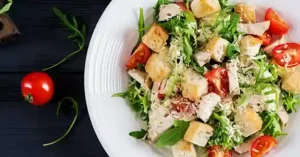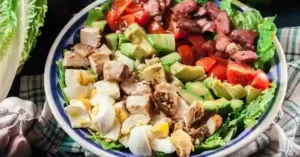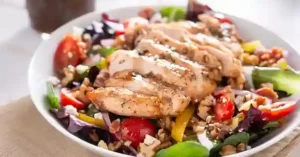Introduction to Ranch Chicken Salad
Ranch Chicken Salad is a delightful fusion of flavors and textures that makes it a standout dish for any occasion. This salad combines tender, juicy chicken with crisp vegetables, all brought together by a rich and tangy homemade ranch dressing. It’s perfect for those looking for a hearty, yet fresh and healthy meal option.

Why You’ll Love This Recipe:
Versatile:
Whether you’re meal prepping for the week, hosting a casual lunch, or bringing a dish to a potluck, this salad fits the bill. It’s easy to scale up or down depending on your needs.
Nutritious:
Packed with protein from the chicken and a variety of vitamins and minerals from the vegetables, this salad is as nutritious as it is tasty. You can also customize it with additional healthy ingredients to suit your dietary preferences.
Quick and Easy:
With simple ingredients and straightforward steps, this recipe is perfect for both novice and experienced cooks. The homemade ranch dressing adds a special touch, elevating the flavor without adding much prep time.
Customizable:
The base recipe is flexible, allowing you to add or substitute ingredients based on what’s available or your personal taste. From adding a bit of bacon for extra richness to incorporating seasonal veggies, the possibilities are endless.

Ingredients Needed Ranch Chicken Salad Recipe
Creating a flavorful Ranch Chicken Salad begins with selecting the right ingredients. Here’s a detailed breakdown of what you’ll need:
Main Ingredients for the Salad:
Chicken:
- Type: Boneless, skinless chicken breasts or thighs are ideal. You can also use rotisserie chicken for convenience.
- Preparation: Grilled, baked, or poached chicken works best. Season lightly with salt, pepper, and a touch of olive oil for flavor.
Vegetables:
- Lettuce: Use a mix of Romaine and iceberg for a crisp base. Baby spinach or arugula can add a peppery flavor.
- Tomatoes: Cherry or grape tomatoes, halved, provide sweetness and acidity.
- Cucumbers: Thinly sliced or diced for a refreshing crunch.
- Red Onion: Sliced thin for a subtle sharpness.
- Bell Peppers: Use a variety of colors for a vibrant appearance and sweet flavor.
Bacon:
- Type: Use crispy cooked bacon for a savory, crunchy element. Turkey bacon is a healthier alternative.
Cheese:
- Type: Shredded cheddar or crumbled blue cheese adds creaminess and depth. Feta or Parmesan are also great options.
Homemade Ranch Dressing:
- Base: Combine mayonnaise, sour cream, and buttermilk.
- Flavorings: Add garlic powder, onion powder, dried dill, parsley, and chives.
- Acid: A splash of lemon juice or white vinegar brightens the dressing.
Optional Add-Ins:
- Avocado: Sliced or diced, avocado adds creaminess and healthy fats.
- Boiled Eggs: For extra protein and richness.
- Olives: Black or Kalamata olives provide a briny contrast.
- Corn: Fresh, canned, or grilled corn kernels add sweetness and texture.
- Nuts or Seeds: Almonds, sunflower seeds, or pecans offer crunch and additional nutrients.
Ingredient Tips:
- Freshness: Always use fresh vegetables and herbs for the best flavor and texture.
- Customization: Feel free to adjust the quantities based on your taste and dietary needs. For a lighter salad, reduce the cheese and bacon, and load up on vegetables.
- Dressing: Making the dressing from scratch allows you to control the ingredients and adjust the flavors to your preference.

Homemade Ranch Dressing
The homemade ranch dressing is the star of this salad, bringing together all the flavors and adding a creamy, tangy finish. Making your dressing from scratch not only enhances the taste but also allows you to control the ingredients and adjust the flavors to your liking. Here’s how to prepare a delicious ranch dressing:
Ingredients for the Ranch Dressing:
Base:
- Mayonnaise: 1 cup. Use a good quality mayonnaise for a creamy texture.
- Sour Cream: 1/2 cup. Adds tanginess and a smooth consistency.
- Buttermilk: 1/2 cup. Adjust the amount to reach your desired thickness. Buttermilk gives the dressing a tangy flavor and makes it pourable.
Herbs and Spices:
- Garlic Powder: 1 teaspoon. For a subtle garlic flavor.
- Onion Powder: 1 teaspoon. Adds a mild onion taste.
- Dried Dill: 1 teaspoon. Dill is a classic herb in ranch dressing, adding a fresh and slightly tangy flavor.
- Dried Parsley: 1 tablespoon. Brings a mild, fresh note.
- Dried Chives: 1 tablespoon. Provides a mild onion-like flavor.
Acid:
- Lemon Juice or White Vinegar: 1 tablespoon. Adds brightness and enhances the tanginess of the dressing.
Seasoning:
- Salt and Pepper: To taste. Start with 1/2 teaspoon salt and 1/4 teaspoon black pepper, then adjust as needed.
Instructions:
Combine the Base Ingredients:
In a medium-sized bowl, whisk together the mayonnaise, sour cream, and buttermilk until smooth and well combined. The buttermilk helps thin the dressing to a pourable consistency.
Add Herbs and Spices:
Stir in the garlic powder, onion powder, dried dill, dried parsley, and dried chives. Mix until the herbs and spices are evenly distributed throughout the dressing.
Add the Acid:
Mix in the lemon juice or vinegar. This ingredient brightens the flavor and adds a refreshing tang. Start with the recommended amount and adjust to taste.
Season the Dressing:
Season with salt and pepper to taste. Adjust based on your preference and the saltiness of the other ingredients.
Chill and Serve:
For the best flavor, refrigerate the dressing for at least 30 minutes before serving. This allows the flavors to meld together. If the dressing thickens too much in the fridge, thin it with a little more buttermilk.
Tips for the Best Ranch Dressing:
Freshness:
While dried herbs are used for convenience, using fresh herbs (such as fresh dill, parsley, and chives) can enhance the flavor and appearance of the dressing. Use double the amount of fresh herbs compared to dried.
Consistency:
Adjust the thickness of the dressing by adding more buttermilk for a thinner consistency or more mayonnaise for a thicker texture.
Storage:
Store the homemade ranch dressing in an airtight container in the refrigerator for up to a week. Stir well before each use as it may separate over time.

Kitchen Tools Required
Preparing a Ranch Chicken Salad with homemade dressing doesn’t require a lot of specialized equipment, but having the right tools can make the process smoother and more efficient. Here’s a list of the essential kitchen tools you’ll need:
Cutting Board:
Purpose:
A sturdy cutting board is essential for chopping vegetables, slicing chicken, and preparing other ingredients. Choose one with a non-slip surface for safety.
Chef’s Knife:
Purpose:
A sharp chef’s knife is crucial for efficiently and safely cutting vegetables, chicken, and herbs. Keeping the knife sharp will make prep work easier and more precise.
Mixing Bowls:
Purpose:
You’ll need a set of mixing bowls in various sizes. Use larger bowls for tossing the salad and smaller ones for mixing the dressing or preparing individual ingredients.
Measuring Cups and Spoons:
Purpose:
Accurate measurements are important, especially when making the homemade ranch dressing. Use dry measuring cups for solid ingredients and liquid measuring cups for liquids.
Whisk:
Purpose:
A whisk is ideal for mixing the dressing ingredients thoroughly, ensuring a smooth and well-blended result.
Tongs:
Purpose:
Use tongs to toss the salad ingredients together, ensuring that everything is evenly coated with dressing without damaging delicate ingredients.
Salad Spinner (Optional but Recommended):
Purpose:
If you’re using fresh greens, a salad spinner helps dry them thoroughly after washing. This prevents the salad from becoming watery and ensures the dressing sticks better.
Grater (Optional):
Purpose:
If you’re adding cheese or vegetables like carrots, a grater can help you prepare these ingredients quickly.
Small Jar or Container with Lid (Optional):
Purpose:
If you’re preparing the dressing in advance, use a jar or container with a lid for easy storage and shaking. This makes it easy to remix the dressing before use.
Serving Utensils:
Purpose:
Large serving spoons or a salad fork and spoon set are useful for serving the salad. They help in portioning out the salad without crushing the ingredients.
Additional Tips:
- Preparation Area: Ensure you have a clean and organized workspace. This makes the cooking process more efficient and enjoyable.
- Cleanup: Have a trash bowl or bag nearby to collect scraps as you prep, making cleanup easier.
- Safety: Always handle sharp tools with care and use a stable surface for cutting to prevent accidents.

Step-by-Step Instructions
Creating a Ranch Chicken Salad is straightforward, especially with a clear plan. Here’s a step-by-step guide to preparing this delicious and satisfying salad:
Prepare the Chicken
Cooking Options:
Grilling:
Preheat your grill to medium-high heat. Season the chicken breasts with salt, pepper, and a drizzle of olive oil. Grill for 5-7 minutes per side, or until the internal temperature reaches 165°F (74°C). Let the chicken rest for 5 minutes before slicing.
Baking:
Preheat your oven to 375°F (190°C). Place the chicken breasts on a baking sheet lined with parchment paper. Season and bake for 20-25 minutes, or until fully cooked. Allow the chicken to cool slightly, then slice or shred.
Poaching:
In a pot, bring water or chicken broth to a simmer. Add the chicken breasts and cook for about 15 minutes, or until done. Remove the chicken and shred or chop into bite-sized pieces.
Prepare the Vegetables
Lettuce and Greens:
Wash and dry the lettuce and greens thoroughly. Use a salad spinner for best results. Tear or chop the leaves into bite-sized pieces.
Tomatoes:
Wash and halve cherry or grape tomatoes.
Cucumbers:
Peel and slice cucumbers thinly, or dice them into small cubes.
Red Onion:
Peel and thinly slice the red onion.
Bell Peppers:
Core and slice the bell peppers into thin strips.
Cook the Bacon (if using)
Stovetop:
Cook bacon slices in a skillet over medium heat until crispy. Transfer to a paper towel-lined plate to drain excess fat, then crumble into pieces.
Oven:
Alternatively, bake the bacon at 400°F (200°C) on a lined baking sheet for 15-20 minutes or until crispy. Crumble when cool.
Assemble the Salad
Base Layer:
In a large salad bowl, place the prepared lettuce and greens as the base.
Add Vegetables:
Layer the tomatoes, cucumbers, red onions, and bell peppers over the greens.
Add Protein:
Arrange the sliced or shredded chicken evenly over the salad.
Add Toppings:
Sprinkle the crumbled bacon and shredded cheese (such as cheddar or blue cheese) on top.
Dress the Salad
Homemade Ranch Dressing:
Drizzle the homemade ranch dressing over the salad. Start with a small amount and add more to taste. Toss gently to combine, ensuring the dressing coats the ingredients evenly.
Final Touches
Optional Add-Ins:
Add sliced avocado, boiled eggs, olives, corn, or nuts/seeds for extra flavor and texture.
Seasoning:
Season the salad with freshly ground black pepper or additional salt if desired.
Serve the Salad
Serving:
Serve immediately to enjoy the freshness of the ingredients. If not serving right away, store the salad and dressing separately to prevent the greens from becoming soggy.
Tips for Best Results:
- Chill the Dressing: For the best flavor, chill the homemade ranch dressing for at least 30 minutes before using.
- Freshness: Use fresh, high-quality ingredients for the best taste and texture.
- Customization: Adjust the ingredients based on your preferences, such as using turkey bacon for a lighter option or adding spicy elements like jalapeños.

Recipe Tips and Variations
Creating a perfect Ranch Chicken Salad involves more than just following the recipe; it also includes applying some handy tips and exploring variations to suit different tastes and dietary needs. Here are some tips and variations to enhance your salad:
Recipe Tips
Use Fresh Ingredients:
Always opt for the freshest vegetables, herbs, and chicken. Fresh ingredients not only enhance the flavor but also improve the nutritional value of your salad.
Properly Cook the Chicken:
Ensure the chicken is cooked thoroughly but not overcooked, which can make it dry. For juicier chicken, consider marinating it before cooking.
Balance Flavors:
Taste the salad dressing before adding it to the salad. Adjust the seasoning with salt, pepper, or a splash of lemon juice to achieve the perfect balance of flavors.
Chill the Salad:
If time allows, chill the salad for about 10-15 minutes before serving. This helps meld the flavors and makes the salad more refreshing, especially on hot days.
Cut Ingredients Uniformly:
Chop vegetables and chicken into bite-sized, uniform pieces for a more cohesive texture and better presentation.
Serve Immediately After Dressing:
Toss the salad with dressing just before serving to prevent the greens from wilting. If preparing in advance, store the dressing separately.
Recipe Variations
Vegetarian Version:
Replace the chicken with grilled tofu, chickpeas, or a plant-based chicken substitute. You can also add extra beans or grains like quinoa for additional protein.
Dairy-Free Option:
For a dairy-free dressing, use dairy-free yogurt or mayonnaise, and replace buttermilk with a dairy-free milk mixed with a tablespoon of lemon juice or vinegar. Use dairy-free cheese or omit cheese altogether.
Low-Carb Version:
Focus on low-carb vegetables like leafy greens, cucumbers, and bell peppers. Skip high-carb ingredients like corn and opt for additional proteins like eggs or avocado.
Spicy Variation:
Add a kick to your salad by incorporating spicy elements like jalapeños, red pepper flakes, or a dash of hot sauce in the dressing. You can also use a spicy cheese like pepper jack.
Mediterranean Twist:
Substitute the ranch dressing with a Greek yogurt-based dressing, and add Mediterranean ingredients like olives, feta cheese, and cherry tomatoes. Include herbs like oregano and mint for added flavor.
Fruit Additions:
For a sweet and savory contrast, add fruits such as apple slices, dried cranberries, or grapes. These add a pop of sweetness and complement the creamy dressing.
Different Proteins:
Swap chicken for other proteins like turkey, shrimp, or even steak strips. These variations can completely change the character of the salad while keeping it delicious.
Herb Enhancements:
Fresh herbs like basil, cilantro, or dill can be added to the salad for a burst of flavor. They can also be incorporated into the dressing.
Crunchy Elements:
Add croutons, toasted nuts, or seeds like sunflower or pumpkin seeds for an extra crunchy texture.
Presentation Tips
- Layering: Arrange the salad ingredients in layers in a clear bowl or on a platter to showcase the vibrant colors and textures.
- Garnishing: Top with a sprinkle of fresh herbs, a drizzle of extra dressing, or a few slices of avocado or boiled egg for a visually appealing finish.

Serving Suggestions
Ranch Chicken Salad is a versatile dish that can be served in various ways, making it suitable for different occasions and meal preferences. Here are some creative serving suggestions to elevate your salad presentation and experience:
Traditional Salad Plate
Serving Method:
Arrange the Ranch Chicken Salad on a large serving plate or individual plates. Start with a bed of lettuce and greens, then layer with chicken, vegetables, and toppings.
Presentation Tips:
Garnish with fresh herbs, additional dressing drizzles, or a sprinkle of cheese. Serve with a wedge of lemon or lime on the side for an extra burst of freshness.
Salad Wraps
Serving Method:
Use large lettuce leaves (such as Romaine or butter lettuce) or tortilla wraps to create handheld salad wraps.
Presentation Tips:
Spread a layer of dressing on the wrap, add a portion of the salad mixture, and then roll tightly. Secure with toothpicks and slice in half for easy eating. This method is perfect for a light lunch or picnic.
Stuffed Avocados or Tomatoes
Serving Method:
Hollow out large avocados or tomatoes and fill them with the salad mixture. This presentation is elegant and adds a unique twist to the dish.
Presentation Tips:
Use a melon baller or spoon to carefully scoop out the flesh, creating a well for the salad. Garnish with herbs or a drizzle of dressing on top.
Salad Boats
Serving Method:
Serve the salad in hollowed-out bell peppers or cucumber boats for a colorful and crunchy presentation.
Presentation Tips:
Cut bell peppers or cucumbers lengthwise and remove seeds. Fill with salad and garnish with fresh herbs or cheese crumbles.
Bread Bowls
Serving Method:
Hollow out small round loaves of bread to create edible bowls. Fill with the salad for a hearty and satisfying meal.
Presentation Tips:
Choose crusty bread that can hold the salad without becoming soggy. Serve with the bread pieces on the side for dipping.
Pasta Salad Variation
Serving Method:
Combine the Ranch Chicken Salad ingredients with cooked pasta to create a pasta salad variation.
Presentation Tips:
Use pasta shapes like rotini or penne, which hold the dressing well. This is a great option for potlucks or picnics.
Topped on Grains
Serving Method:
Serve the salad over a base of grains such as quinoa, rice, or farro for a more filling meal.
Presentation Tips:
Layer the grains on a platter, then top with the salad mixture. This combination adds texture and makes the dish more substantial.
As a Dip
Serving Method:
Mix the salad ingredients finely and serve as a dip with crackers, pita chips, or vegetable sticks.
Presentation Tips:
This is a great option for parties or as an appetizer. Provide a variety of dippers for guests to enjoy.
Layered Salad in a Jar
Serving Method:
For a portable and visually appealing option, layer the salad ingredients in a mason jar. Start with the dressing, then add heavier ingredients like chicken and vegetables, and top with greens.
Presentation Tips:
This method is perfect for meal prepping or serving on-the-go. Shake the jar before eating to distribute the dressing.
Pairing Suggestions
Side Dishes:
Serve the Ranch Chicken Salad with a side of crusty bread, garlic bread, or a simple soup. It pairs well with light soups like tomato basil or a broth-based vegetable soup.
Beverages:
Complement the salad with refreshing beverages like iced tea, lemonade, or a light white wine.

Storing Leftovers
Properly storing leftovers from your Ranch Chicken Salad is key to maintaining its freshness and flavor. Here’s how to ensure your salad stays delicious and safe to eat:
Store the Salad and Dressing Separately
Reason: To prevent the salad from becoming soggy, always store the salad and dressing in separate containers. This will keep the greens and other ingredients crisp.
Method: Place the salad ingredients in an airtight container and keep the dressing in a separate jar or container with a tight-fitting lid.
Refrigeration
Salad: Store the salad in an airtight container in the refrigerator. It’s best to consume the salad within 3-4 days for optimal freshness.
Dressing: The homemade ranch dressing can also be stored in the refrigerator. It will keep well for up to 1 week.
Freezing (If Applicable)
Salad: Freezing is generally not recommended for salads with fresh vegetables and lettuce, as these ingredients can become wilted and mushy after thawing.
Dressing: If you need to freeze the dressing, place it in a freezer-safe container or zip-top bag. It can be frozen for up to 3 months. Thaw in the refrigerator overnight before using, and give it a good stir to recombine any separated ingredients.
Reheating
Chicken: If the chicken was prepared in advance and is stored separately, it can be reheated in the microwave or oven. Make sure to reheat it to an internal temperature of 165°F (74°C) to ensure safety.
Avoid: Do not reheat the entire salad if it includes delicate ingredients like greens, as they will become wilted and unappetizing.
Check for Freshness
Visual and Smell Check: Before consuming leftovers, check for any signs of spoilage, such as off smells or discoloration. If the salad or dressing appears or smells unusual, it’s best to discard it.
Texture: If the texture of the greens or other ingredients seems off, this can be an indication that they are no longer fresh.
Tips for Optimal Storage
Labeling:
Label containers with the date to keep track of how long the leftovers have been stored. This helps ensure you use them within the recommended time frame.
Portioning:
Consider portioning leftovers into smaller containers for easy access and to minimize the number of times the main container is opened, which helps maintain freshness.
Reviving Leftovers
Crispiness:
If the greens become slightly wilted, try adding a bit of fresh lettuce or spinach to revitalize the salad.
Fresh Dressing:
Sometimes, a fresh drizzle of homemade ranch dressing can help refresh leftover salad and enhance its flavor.

Nutrition
Understanding the nutritional content of your Ranch Chicken Salad helps you make informed choices and can aid in maintaining a balanced diet. Here’s a detailed look at the nutrition aspects of this dish:
Nutritional Breakdown
Chicken:
Protein:
Chicken is a high-quality source of protein, which is essential for muscle repair and overall health. A typical serving of cooked chicken breast (3 ounces) provides around 25-30 grams of protein.
Calories:
Chicken breast is relatively low in calories compared to other meats, with approximately 140-165 calories per 3-ounce serving, depending on the preparation method.
Vegetables:
Vitamins and Minerals:
Vegetables like lettuce, tomatoes, cucumbers, and bell peppers are rich in vitamins A, C, and K, as well as minerals such as potassium and magnesium. They also provide dietary fiber, which aids in digestion.
Calories:
Vegetables are low in calories but high in nutrients, making them an excellent addition to any salad. For example, a cup of chopped lettuce has about 10 calories, while a cup of cherry tomatoes has around 30 calories.
Bacon:
Fat and Calories:
Bacon adds flavor and crunch but also contributes fat and calories. A slice of cooked bacon contains approximately 40-50 calories and 3-4 grams of fat, with about 1 gram of saturated fat.
Healthier Options:
To reduce fat content, consider using turkey bacon or limiting the amount used.
Cheese:
Calcium and Protein:
Cheese adds calcium and protein to the salad. A 1-ounce serving of shredded cheddar cheese contains about 110 calories, 9 grams of fat, and 7 grams of protein.
Lower-Fat Alternatives:
If watching fat intake, consider using lower-fat cheese options or reducing the amount used.
Ranch Dressing:
Calories and Fat:
Homemade ranch dressing can be calorie-dense, with approximately 70-100 calories per 2-tablespoon serving, depending on the recipe. It often contains fats from mayonnaise and sour cream.
Reducing Calories:
To make a lighter dressing, use Greek yogurt or reduce the amount of mayonnaise and sour cream.
Caloric Content of a Typical Serving
A typical serving of Ranch Chicken Salad (about 2 cups) with chicken, vegetables, cheese, and dressing can have approximately:
- Calories: 350-500 calories per serving, depending on the ingredients and portion sizes.
- Protein: 25-30 grams of protein, primarily from the chicken and cheese.
- Fat: 20-30 grams of fat, including both saturated and unsaturated fats. This amount varies based on the type and amount of dressing and bacon used.
Health Benefits
Balanced Nutrients:
- Protein: Supports muscle maintenance and repair, and helps keep you feeling full longer.
- Vitamins and Minerals: Vegetables provide essential nutrients for overall health and well-being.
- Healthy Fats: If using avocado or olive oil in the dressing, you can incorporate heart-healthy fats.
Digestive Health:
- Fiber: Vegetables and chicken contribute to fiber intake, which aids in digestion and helps maintain a healthy digestive system.
Dietary Considerations
- Low-Carb: For a low-carb version, reduce or omit ingredients like corn and use a low-carb dressing.
- Gluten-Free: Ensure all ingredients, especially the dressing, are gluten-free if you have gluten sensitivities.
- Dairy-Free: Use dairy-free alternatives for cheese and dressing if you’re lactose intolerant or following a dairy-free diet.
Making Healthier Choices
- Adjust Portions: Be mindful of portion sizes, especially with higher-calorie ingredients like cheese and bacon.
- Customize Ingredients: Choose lean proteins, use less dressing, and opt for more vegetables to boost the nutritional profile of your salad.
Conclusion
Whether you’re preparing a hearty meal for a family gathering or looking for a satisfying lunch option, the Ranch Chicken Salad is a versatile and delicious choice. With its blend of tender chicken, crisp vegetables, and creamy dressing, it’s sure to please a variety of tastes. Remember, this salad is not only easy to customize and adjust based on your preferences but also provides numerous opportunities for creative variations. If you enjoyed this recipe, don’t miss the chance to explore other delightful salads like Chicken Caesar or Southwest Chicken Salad. Each offers unique flavors and ingredients that can add a fresh twist to your meal planning. Happy cooking and enjoy discovering new favorites!
FAQS

Ranch Chicken Salad Recipe
Equipment
- Cutting board
- Chef's Knife
- Mixing Bowls
- Cups and Spoons
Ingredients
- 2 cups cooked chicken breast shredded or diced
- 1 cup cherry tomatoes halved
- 1 cup cucumber diced
- 1/2 cup red onion finely sliced
- 1/2 cup corn kernels fresh, frozen, or canned
- 1/2 cup black beans rinsed and drained
- 1 cup shredded cheddar cheese
- 1/2 cup crumbled bacon optional
- 2 cups chopped romaine lettuce or mixed greens
- 1/2 cup ranch dressing
- Salt and pepper to taste
- Fresh herbs such as parsley or cilantro, for garnish
Instructions
- Prepare the Chicken: If not already done, cook the chicken breast until fully cooked and then shred or dice it into bite-sized pieces.
- Combine Ingredients: In a large mixing bowl, combine the chicken, cherry tomatoes, cucumber, red onion, corn, black beans, and shredded cheese.
- Add Dressing: Pour the ranch dressing over the salad mixture and toss until everything is well coated. Season with salt and pepper to taste.
- Serve Over Greens: Place a bed of chopped romaine lettuce or mixed greens on individual serving plates. Spoon the chicken salad mixture over the greens.
- Garnish and Serve: Top with crumbled bacon if using and fresh herbs for garnish. Serve immediately.
